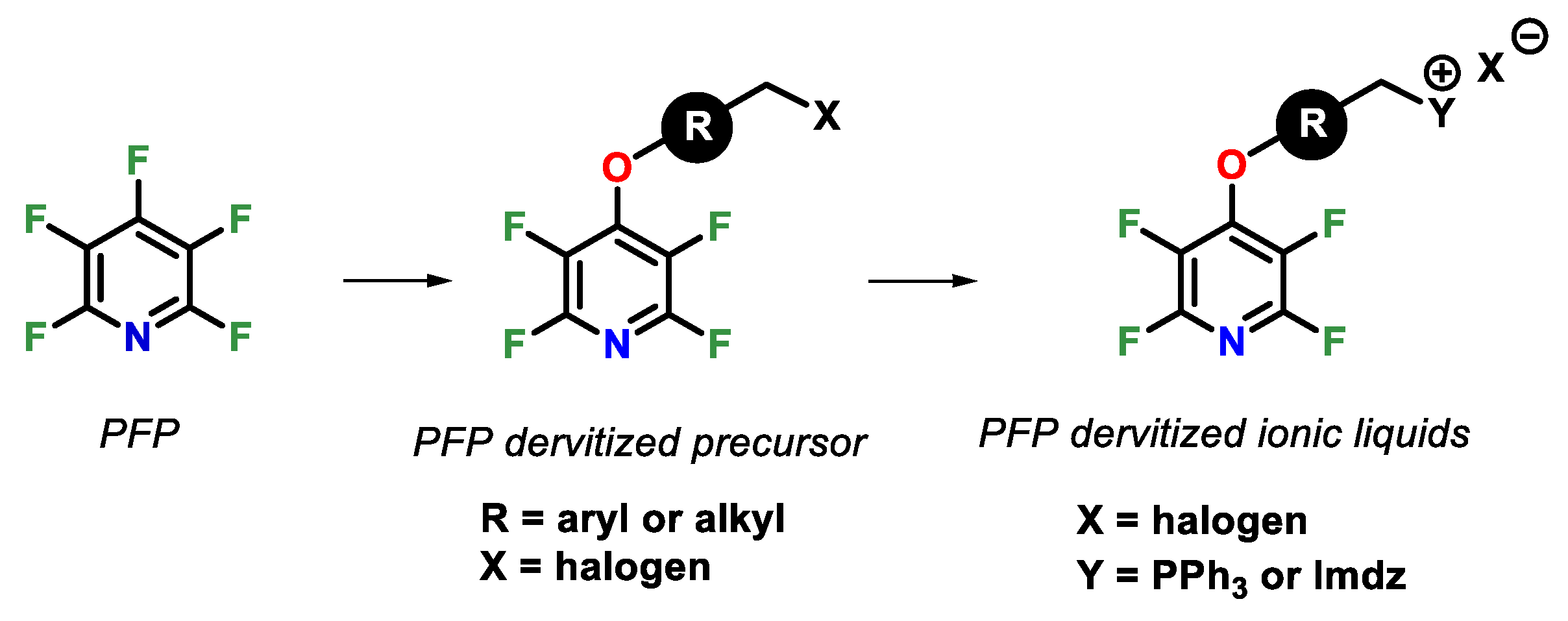4-(4-(2-Bromoethyl)phenoxy)-2,3,5,6-tetrafluoropyridine
Abstract
:1. Introduction
2. Results and Discussion
3. Materials and Methods
4-(4-(2-Bromoethyl)phenoxy)-2,3,5,6-tetrafluoropyridine (1)
Supplementary Materials
Author Contributions
Funding
Data Availability Statement
Acknowledgments
Conflicts of Interest
References
- Fabre, E.; Murshed, S.M.S. A Review of the Thermophysical Properties and Potential of Ionic Liquids for Thermal Applications. J. Mater. Chem. A 2021, 9, 15861–15879. [Google Scholar] [CrossRef]
- Gonçalves, A.R.P.; Paredes, X.; Cristino, A.F.; Santos, F.J.V.; Queirós, C.S.G.P. Ionic Liquids—A Review of Their Toxicity to Living Organisms. Int. J. Mol. Sci. 2021, 22, 5612. [Google Scholar] [CrossRef] [PubMed]
- Moore, L.M.J.; Greeson, K.T.; Redeker, N.D.; Zavala, J.J.; Le, T.C.; Gilmore, L.V.; Thompson, K.B.; Marcischak, J.C.; Quintana, A.S.; Teat, S.J.; et al. Fluoroalkyl-functional Imidazoles and Imidazolium–Based Ionic Liquids Prepared via Thiol-ene/yne Click Chemistry. J. Mol. Liq. 2019, 295, 111677. [Google Scholar] [CrossRef]
- Langtry, A.E.; Thompson, K.B.; Redeker, N.D.; Quintana, A.S.; Bui, D.L.; Greeson, K.T.; Cena, N.; Marcischak, J.C.; Moore, L.M.J.; Ghiassi, K.B. Fluorinated Phosphonium Salts and Ionic Liquids Prepared via Thiol-ene Click Chemistry: A Physical and Thermal Property Study. J. Mol. Liq. 2022, 359, 119282. [Google Scholar] [CrossRef]
- Knoop, J.E.; Alston, J.R. Microwave-assisted Synthesis of 1-(perfluorohexyl)-3-methylimidazolium iodide. MRS Adv. 2020, 5, 1449–1456. [Google Scholar] [CrossRef]
- Neumann, C.N.; Hooker, J.M.; Ritter, T. Concerted Nucleophilic Aromatic Substitution with 19F− and 18F−. Nature 2016, 534, 369–373. [Google Scholar] [CrossRef]
- Sandford, G. Perfluoroheteroaromatic Chemistry: Multifunctional Systems from Perfluorinated Heterocycles by Nucleophilic Aromatic Substitution Processes. In Halogenated Heterocycles: Synthesis, Application and Environment; Iskra, J., Ed.; Springer: Berlin/Heidelberg, Germany, 2012; pp. 1–31. ISBN 978-3-642-43950-6. [Google Scholar]
- Fuhrer, T.; Houck, M.; Corley, C.A.; Iacono, S.T. Theoretical Explanation of Reaction Site Selectivity in the Addition of a Phenoxy Group to Perfluoropyridine. J. Phys. Chem. A 2019, 123, 9450–9455. [Google Scholar] [CrossRef]
- Brittain, W.D.G.; Cobb, S.L. Tetrafluoropyridyl (TFP): A General Phenol Protecting Group Readily Cleaved under Mild Conditions. Org. Biomol. Chem. 2019, 17, 2110–2115. [Google Scholar] [CrossRef] [PubMed]
- Murray, C.B.; Sandford, G.; Korn, S.R.; Yufit, D.S.; Howard, J.A. New fluoride ion reagent from pentafluoropyridine. J. Fluorine Chem. 2005, 126, 569–574. [Google Scholar] [CrossRef]
- Brittain, W.G.D.; Cobb, S.L. Carboxylic Acid Deoxyfluorination and One-Pot Amide Bond Formation Using Pentafluoropyridine (PFP). Org. Lett. 2021, 23, 5793–5798. [Google Scholar] [CrossRef] [PubMed]
- Senaweera, S.M.; Singh, A.; Weaver, J.D. Photocatalytic Hydrodefluorination: Facile Access to Partially Fluorinated Aromatics. J. Am. Chem. Soc. 2014, 136, 3002–3005. [Google Scholar] [CrossRef] [PubMed]
- Froese, R.D.J.; Whiteker, G.T.; Peterson, T.H.; Arriola, D.J.; Renga, J.M.; Shearer, J.W. Computational and Experimental Studies of Regioselective SNAr Halide Exchange (Halex) Reactions of Pentachloropyridine. J. Org. Chem. 2016, 81, 10672–10682. [Google Scholar] [CrossRef] [PubMed]
- Kenny, J.K.; Medlin, J.W.; Beckham, G.T. Quantification of Phenolic Hydroxyl Groups in Lignin via 19F NMR Spectroscopy. ACS Sustain. Chem. Eng. 2023, 11, 5644–5655. [Google Scholar] [CrossRef]
- Gautam, R.; Geniza, I.; Iacono, S.T.; Friesen, C.M.; Jennings, A.R. Perfluoropyridine: Discovery, Chemistry, and Applications in Polymers and Material Science. Molecules 2022, 27, 1616. [Google Scholar] [CrossRef] [PubMed]
- Freisen, C.M.; Kelly, A.R.; Iacono, S.T. Shaken Not Stirred: Perfluoropyridine Polyalkylether Prepolymers. Macromolecules 2022, 55, 10970–10979. [Google Scholar] [CrossRef]
- Althagbi, H.I.; Edwards, A.J.; Nicholson, B.K.; Reason, D.A.; Saunders, G.C.; Sim, S.A.; Heijden, D.A. Arene-Perfluoroarene-Anion Stacking and Hydrogen Bonding Interactions in Imidazolium Salts for the Crystal Engineering of Polarity. Crys. Growth Des. 2016, 16, 174–188. [Google Scholar] [CrossRef]
- Ansari, Y.; Ueno, K.; Angell, C.A. Protic Ionic Liquids Can Be Both Free Proton Conductors and Benign Superacids. J. Phys.Chem. B 2021, 125, 7855–7862. [Google Scholar] [CrossRef] [PubMed]


Disclaimer/Publisher’s Note: The statements, opinions and data contained in all publications are solely those of the individual author(s) and contributor(s) and not of MDPI and/or the editor(s). MDPI and/or the editor(s) disclaim responsibility for any injury to people or property resulting from any ideas, methods, instructions or products referred to in the content. |
© 2023 by the authors. Licensee MDPI, Basel, Switzerland. This article is an open access article distributed under the terms and conditions of the Creative Commons Attribution (CC BY) license (https://creativecommons.org/licenses/by/4.0/).
Share and Cite
Li, T.H.; Messer, L.C.; Weeks, N.J.; Fuhrer, T.J.; Iacono, S.T. 4-(4-(2-Bromoethyl)phenoxy)-2,3,5,6-tetrafluoropyridine. Molbank 2023, 2023, M1730. https://doi.org/10.3390/M1730
Li TH, Messer LC, Weeks NJ, Fuhrer TJ, Iacono ST. 4-(4-(2-Bromoethyl)phenoxy)-2,3,5,6-tetrafluoropyridine. Molbank. 2023; 2023(3):M1730. https://doi.org/10.3390/M1730
Chicago/Turabian StyleLi, Tiffany H., Lucas C. Messer, Nathan J. Weeks, Timothy J. Fuhrer, and Scott T. Iacono. 2023. "4-(4-(2-Bromoethyl)phenoxy)-2,3,5,6-tetrafluoropyridine" Molbank 2023, no. 3: M1730. https://doi.org/10.3390/M1730





